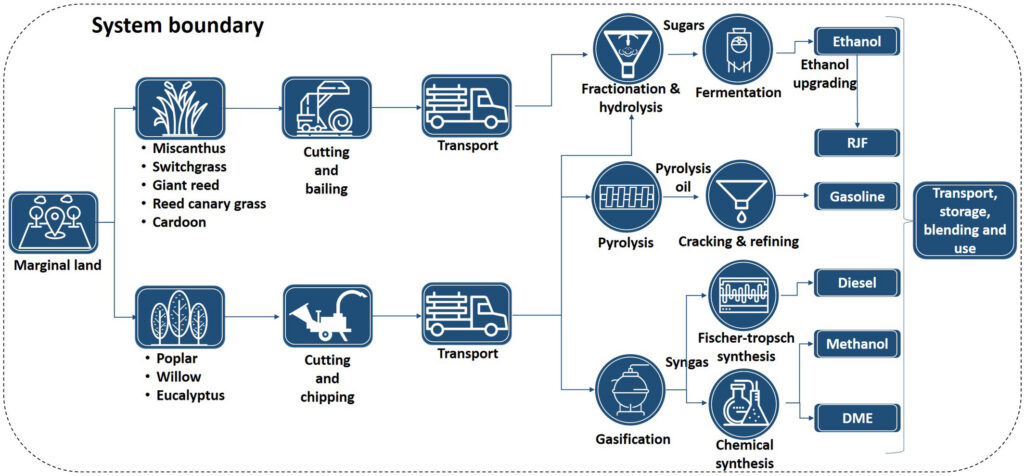Supply potential of lignocellulosic energy crops grown on marginal land in the EU
Oct 2022
Publications
Full title: “Supply potential of lignocellulosic energy crops grown on marginal land and greenhouse gas footprint of advanced biofuels—A spatially explicit assessment under the sustainability criteria of the Renewable Energy Directive Recast”
Advanced biofuels produced from lignocellulosic crops grown on marginal lands can become an important part of the European Union (EU) climate change mitigation strategy to reduce CO2 emissions and meet biofuel demand. This study quantifies spatially explicit the availability of marginal land in the EU, its production biomass potentials for eight different crops, and the greenhouse gas (GHG) performance of advanced biofuel supply chains.
Approach: Available land is mapped based on land marginality and Renewable Energy Directive Recast (REDII) land-related sustainability criteria. Biomass potentials are assessed with a water-use-to-biomass-production approach while considering the available land, location-specific biophysical conditions and crop-specific phenological characteristics. The GHG balance of advanced biofuels from energy crops produced on marginal lands is assessed considering both land-related carbon stock changes and supply chain emissions with the carbon footprint approach from the REDII.
Main conclusions:
– Available marginal land in the EU that meets REDII criteria is projected at 20.5–21 million ha 2030 and 2050, respectively. Due to biophysical limitations, not all available land is suitable for energy crop production. The maximum biomass potential of lignocellulosic energy crops (optimal crop choice with maximum yield for each available location) in the EU is assessed at 1.95 EJ per year in 2030 to 2.26 EJ per year in 2050.
– The GHG emission performance (net emissions) of different advanced biofuel supply chains varies on average between −32 g CO2-eq per MJ fuel for poplar/willow diesel to 38 g CO2-eq per MJ fuel for reed canary grass renewable jet fuel. The large variability in GHG performance is strongly determined by the spatial heterogeneity, which dictates the type of feedstock produced under specific local biophysical conditions, the crop characteristics, and the best conversion pathway. Negative GHG emissions are related to increased carbon stocks for the biomass and soil organic carbon pools compared to the land prior to conversion.
– When for each location, the advanced biofuel supply chain with the highest GHG performance (lowest net GHG emissions) is selected, 618 PJ per year of advanced biofuels can be produced by 2030. Under REDII GHG emission criteria, slightly less (552 PJ per year) is viable. Smart choices on location, crop type and supply chain design are paramount to achieve maximum benefits of bioenergy systems.
Figure: Advanced biofuel pathways from lignocellulosic energy crops included in this study
This publication is part of the ADVANCEFUEL project, funded by the European Union’s Horizon 2020 research and innovation program. This publication is also part of IEA Bioenergy task 45 – Climate and sustainability effect of bioenergy within the broader economy.
Citation: Vera, I., Hoefnagels R., Junginger M., & van der Hilst F. (2021). Supply potential of lignocellulosic energy crops grown on marginal land and greenhouse gas footprint of advanced biofuels— A spatially explicit assessment under the sustainability criteria of the Renewable Energy Directive Recast. GCB Bioenergy, 13, 1425– 1447. https://doi.org/10.1111/gcbb.12867


